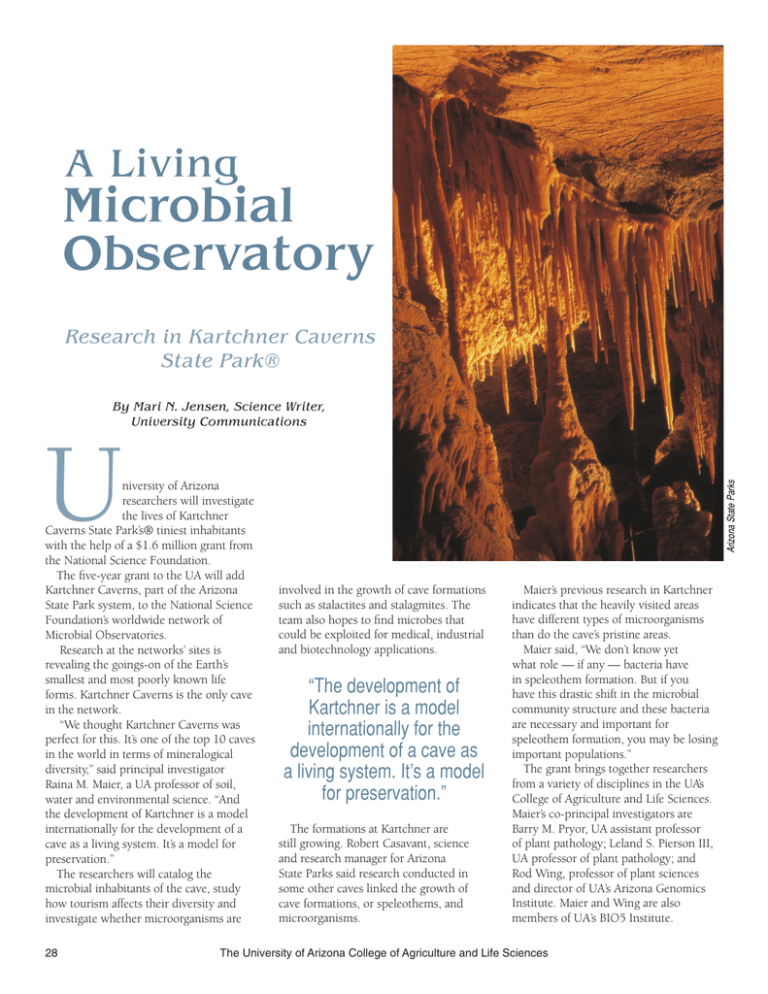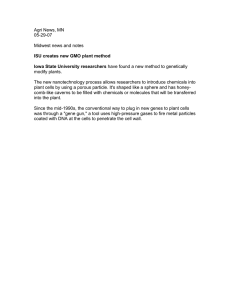U Microbial Observatory A Living
advertisement

A Living Microbial Observatory Research in Kartchner Caverns State Park® By Mari N. Jensen, Science Writer, University Communications 28 Arizona State Parks U niversity of Arizona researchers will investigate the lives of Kartchner Caverns State Park’s® tiniest inhabitants with the help of a $1.6 million grant from the National Science Foundation. The five-year grant to the UA will add Kartchner Caverns, part of the Arizona State Park system, to the National Science Foundation’s worldwide network of Microbial Observatories. Research at the networks’ sites is revealing the goings-on of the Earth’s smallest and most poorly known life forms. Kartchner Caverns is the only cave in the network. “We thought Kartchner Caverns was perfect for this. It’s one of the top 10 caves in the world in terms of mineralogical diversity,” said principal investigator Raina M. Maier, a UA professor of soil, water and environmental science. “And the development of Kartchner is a model internationally for the development of a cave as a living system. It’s a model for preservation.” The researchers will catalog the microbial inhabitants of the cave, study how tourism affects their diversity and investigate whether microorganisms are involved in the growth of cave formations such as stalactites and stalagmites. The team also hopes to find microbes that could be exploited for medical, industrial and biotechnology applications. “The development of Kartchner is a model internationally for the development of a cave as a living system. It’s a model for preservation.” The formations at Kartchner are still growing. Robert Casavant, science and research manager for Arizona State Parks said research conducted in some other caves linked the growth of cave formations, or speleothems, and microorganisms. Maier’s previous research in Kartchner indicates that the heavily visited areas have different types of microorganisms than do the cave’s pristine areas. Maier said, “We don’t know yet what role — if any — bacteria have in speleothem formation. But if you have this drastic shift in the microbial community structure and these bacteria are necessary and important for speleothem formation, you may be losing important populations.” The grant brings together researchers from a variety of disciplines in the UA’s College of Agriculture and Life Sciences. Maier’s co-principal investigators are Barry M. Pryor, UA assistant professor of plant pathology; Leland S. Pierson III, UA professor of plant pathology; and Rod Wing, professor of plant sciences and director of UA’s Arizona Genomics Institute. Maier and Wing are also members of UA’s BIO5 Institute. The University of Arizona College of Agriculture and Life Sciences The team’s first step is figuring out what’s there. Parts of the cave differ in how deep they are, whether bats live there, whether water is dripping, the amount of carbon dioxide present and how much visitation the area receives. So the team will collect microbes from a range of microhabitats by using the same kind of cotton swabs doctors use to collect throat cultures. The researchers will swab speleothems and also mud, bat guano and the rock walls. The researchers will catalog the microbial inhabitants of the cave, study how tourism affects their diversity and investigate whether microorganisms are involved in the growth of cave formations such as stalactites and stalagmites. Once back in the lab, the researchers will try to grow the microorganisms in petri dishes. Because, many microorganisms are difficult to grow in the lab, the researchers will also extract DNA from each sample, creating a complete genetic inventory for all the microorganisms in each location sampled. The team will scan the DNA for what the scientists call “something interesting.” “That might be a species that shows up all the time — or only shows up once,” Maier said. “Maybe there are bacteria that we find only on speleothems. That would suggest they have a role in speleothem formation.” The team will pick the two most interesting sites for further study. For those two sites, the researchers will analyze all the DNA using a technique called metagenomics. That will let the team figure out what each site’s microorganisms do for a living and what special kinds of environmental challenges they face at that location. Pierson said, “Finding out what abilities the community has gives insights into the local environmental challenges.” For example, microbes from an area that has little iron may be particularly adept at holding onto iron molecules that drip their way. “We will be able to characterize the composition of the microbial communities and their metabolic toolboxes,” Pierson said. Even if the DNA comes from an unknown species, using metagenomics analysis will tell the researchers where the new species fits into the microbial tree of life. Knowing that will help the researchers figure out what’s unique about Kartchner’s microbes. The final step, Maier said, will be to see if the microbes’ metabolic toolboxes can create new natural products that are useful for humans. What the scientists learn will also help the park. “It’s good for Kartchner because there’s an unseen world that we don’t know enough about for managing the cave ecosystem. We know about the big things, but it may be the little things that are also important in managing the cave,” said Casavant. “We’re excited to be able to explore that world with UA as our partner. It’s a wonderful collaboration. We want to manage the state parks based on science.” Ã The final step, Maier said, will be to see if the microbes’ metabolic toolboxes can create new natural products that are useful for humans. What the scientists learn will also help the park. ADDITIONAL COLLABORATORS • Jon Chorover, professor of soil, water and environmental science • Raymond E. Goldstein, UA professor of physics and the Schlumberger Professor of Complex Physical Systems at the University of Cambridge in England • Leslie Gunatilaka, professor and director of the UA Southwest Center for Natural Products Research and Commercialization • Carol Soderlund, research associate professor of plant sciences • Rickard S. Toomey III, director of Mammoth Cave International Center for Science and Learning in Kentucky. Goldstein, Gunatilaka and Soderlund are also members of the UA’s BIO5 Institute Contact Arizona State Parks Raina Maier 520-621-7231 rmaier@ag.arizona.edu Barry Pryor 520-626-5312 bmpryor@u.arizona.edu Leland (Sandy) Pierson 520-621-9419 lsp@u.arizona.edu 2006 Agricultural Experiment Station Research Report 29







